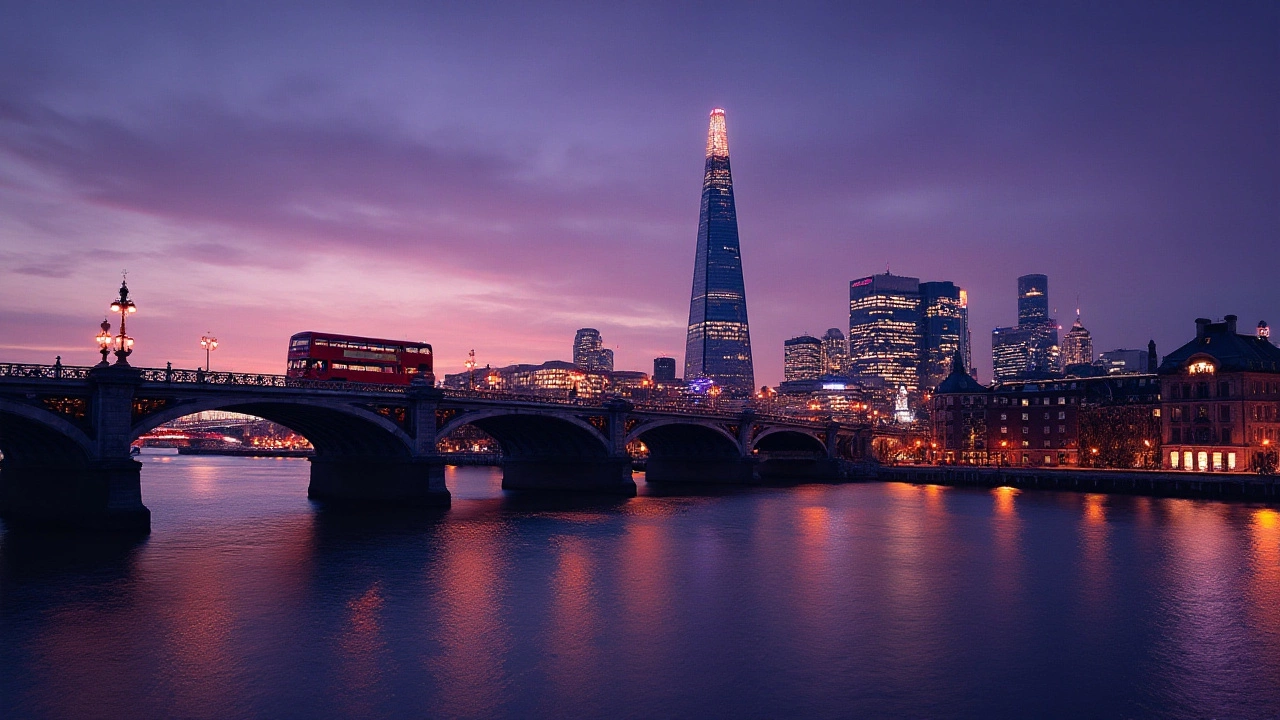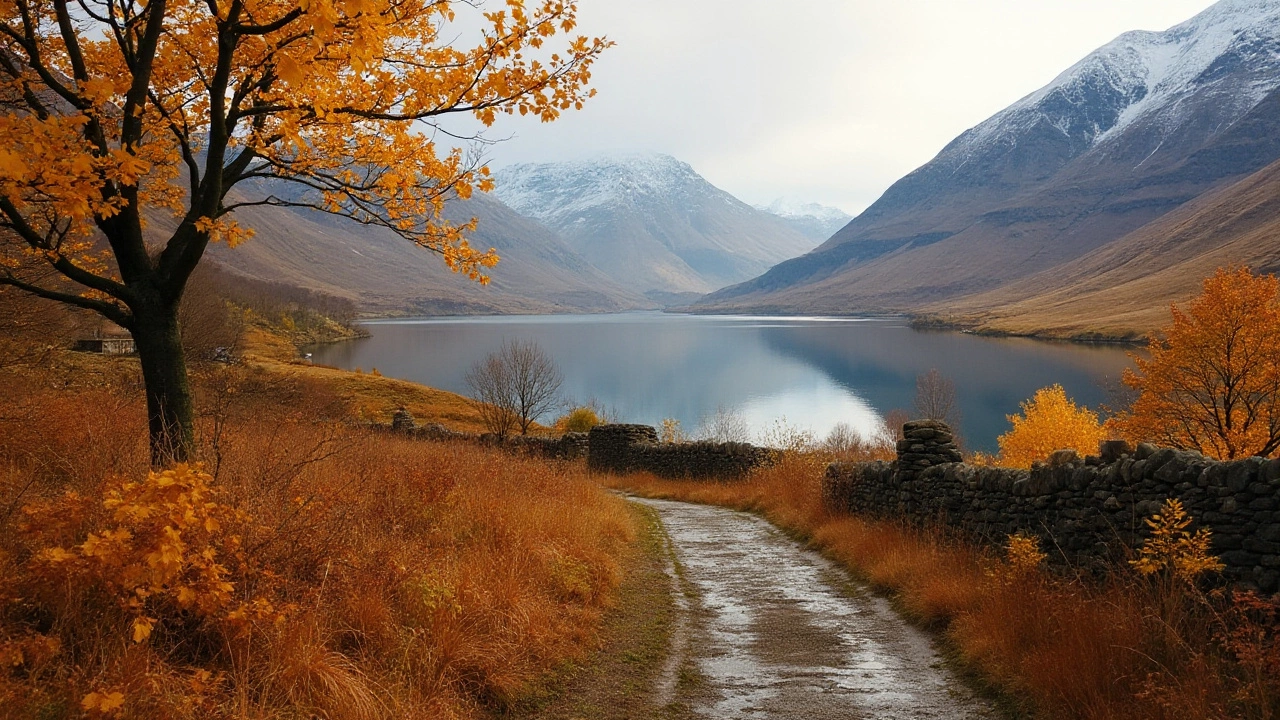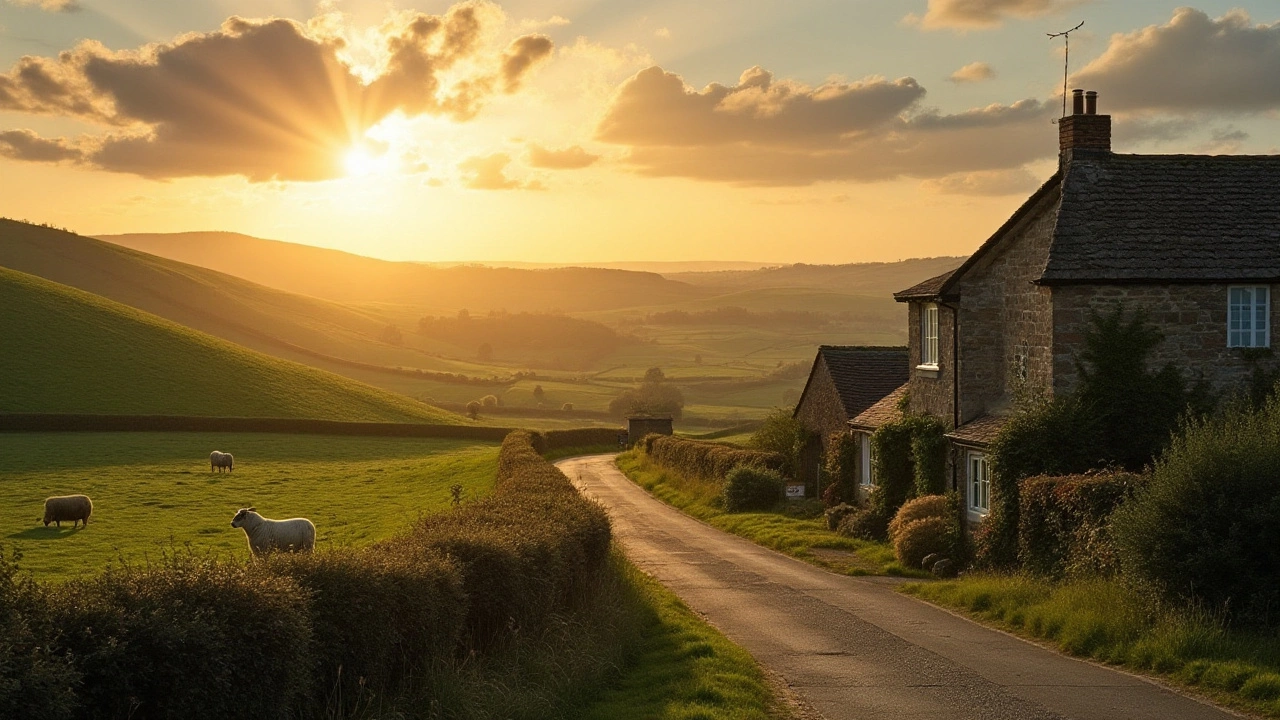Realistic landscape painting is a captivating domain where accuracy meets creativity. This artistic style strives to represent scenes from nature as vividly and truthfully as the eye perceives. It’s a journey that artists embark on to capture the intricate details of their surroundings—be it the subtle play of light on water, the rugged texture of a mountain, or the gentle curve of a hill.
Realism in landscape painting has a rich history, shaped by various movements and masters who have added their own flair to this form. For the uninitiated, entering this world might seem daunting, but understanding its foundations and techniques can demystify the process. In this discussion, we’ll explore what it takes to render a scene so true to life, why artists choose this path, and how one might begin to do the same.
- Defining Realistic Landscape Painting
- Historical Evolution of Realism in Art
- Techniques and Tools for Realistic Landscapes
- Famous Realistic Landscape Artists and Their Work
- Challenges in Achieving Realism
- Tips for Aspiring Realistic Landscape Artists
Defining Realistic Landscape Painting
Realistic landscape painting stands as a remarkable window through which viewers can experience the world around them with a touch of artistic interpretation. This art style seeks to portray natural scenes with such precision and clarity that they appear just as they would in reality, mirroring every nuance and detail. The aim is not only to reproduce the visual aspects of the landscape but to capture the essence and mood of the moment immortalized on canvas. This pursuit of likeness in realism often involves studying the environment meticulously to understand the interplay of light, shadow, and color.
The practice is grounded in observation and detailed work, making it a true test of an artist's patience and perception. When engaging in realistic landscape painting, artists prioritize accuracy in proportion and perspective, understanding that even slight inaccuracies can disrupt the illusion of reality they strive to create. Techniques such as underpainting, glazing, and the use of a limited palette to focus on tonal harmony are common methods artists employ to achieve that striking veracity.
"Art is not what you see, but what you make others see." — Edgar DegasWhile realism in art can be traced back as far as the ancient Greeks, the modern movement truly began during the 19th century as a reaction to the romantic and emotional, often exaggerated, styles that preceded it. This push towards a more truthful representation of the world aligned with the period's growing interest in science and the observable universe. Realism became a way for artists to express an unembellished truth about modern society and the natural world.
One fascinating aspect of realistic landscape painting is its subtle emphasis on storytelling. Despite its focus on accurate depiction, a painting can convey emotion and narrative through color choices, composition, and the depicted moment's atmosphere. This is the invisible thread that binds viewers to a painting, drawing them into an emotional dialogue with the natural world. Paintings by seminal artists like Frederic Edwin Church or Albert Bierstadt highlight this superbly, wherein grandiose landscapes not only reproduce the vista's exactness but also engage with the viewers’ imaginations and spark a deeper appreciation for nature's grandeur.
To achieve this visually arresting effect, aspiring artists must hone their observational skills, understanding that what is omitted from a scene is often as important as what is included. The mantra 'less is more' frequently proves true, as simplicity allows the observer to focus on the brilliance of the artist's intention without distraction. Recognizing the balance between detail and simplicity, as noted by the famous American artist Andrew Wyeth, can be what elevates realistic art from mere reproduction to something profoundly evocative.
Realistic landscape painting, therefore, is not merely a quest for pictorial accuracy but also for emotional authenticity. Artists stretch the boundaries of their technical skills to blend these two aspects seamlessly, aiming not just to illustrate what a place looks like, but what it feels like. This makes realistic landscape painting an endlessly inspiring and challenging pursuit for artists and a source of wonder for all who appreciate the fine arts.
Historical Evolution of Realism in Art
The journey of realism in art is a fascinating tale, filled with shifts and transformations. This artistic movement emerged in the mid-19th century as a response to the romanticized depictions that characterized the prior periods. Realism sought to portray life and nature in their truest forms, prioritizing accuracy over idealization. It arose in France, reaching a crescendo with the works of celebrated artists like Gustave Courbet, who famously declared his intent to depict the world as he saw it without embellishment or alteration. His approach was revolutionary, shifting the landscape of art from the fantastical to the tangible, the mythical to the mundane.
The 19th century was a time of great upheaval, with rapid industrialization and dramatic social change coloring the backdrop of daily life. Artists were moved to record these shifts with precision, seeking authenticity in their creations. The landscape paintings of this era faithfully represented the environment around them, capturing both the beauty and the blemish of nature untouched by human hand. This commitment to realism found its echoes around the world as artists across Europe and America followed suit, some driven by a desire to document the world accurately, others by an intention to spotlight social issues within their communities. Realism became a mirror reflecting the world, inviting viewers to step into scenes that were achingly familiar.
As the movement spread, so did its influence, touching various fora of art beyond mere painting. Writers like Charles Dickens in literature embraced realism to portray everyday struggles, while in art, figures like John Singleton Copley in America adapted their techniques. The advent of photography also pushed painters towards more meticulous renderings of their subjects, for the lens captured truth unerringly. This period also saw the rise of plein air painting—an essential tool for landscape artists—which entailed painting directly from nature to accurately render light and atmosphere.
"I hope to live all my life for my art, without abandoning my principles one iota," stated Courbet, an assertion of the dedication Realist artists had towards their unvarnished portrayals of life.
The realism of this time was more than a challenge to artistic norms—it was a reflection of contemporary society’s desire for transparency and truth. Renowned art historian Linda Nochlin observed that realism in art was not just a depiction but an invitation to engage with the subject matter. It was an approach that encouraged viewers to pause and consider what lay beneath the surface of a painting. As the 19th century gave way to the 20th, realism persisted, albeit adapting to the changing tastes and sensibilities of new generations. The Impressionists took the baton from Realists, infusing their works with light and movement while retaining a commitment to capturing the environment truthfully, albeit with a freer, more expressive brushstroke.
In modern times, realism continues to be a potent force, although now it exists alongside—and often is intertwined with—other styles. Its core principle, the truthful depiction of life's myriad details, remains an inspiration to artists who wish to depict the world as they experience it without resorting to the airs of abstraction or surrealism. This commitment to truthfulness ensures that realism, particularly in landscape painting, remains as vital and relevant today as it was during its inception when sweeping fields and quiet forests first came to life on canvas with unprecedented fidelity.

Techniques and Tools for Realistic Landscapes
Diving into the art of realistic landscape painting involves mastering a variety of techniques and tools, each pivotal in rendering the minutest details and capturing nature's authentic essence. Artists often begin by studying the interplay of light and shadow, essential for achieving depth and dimension. This understanding allows an artist to replicate how the sun casts shadows at different times of the day, adding an intense realism to their work. The use of a limited color palette is also common, as it aids the artist in blending colors to create harmonized tones that emulate the natural world. This technique, known as color harmony, balances hues to evoke the same sensations viewers might experience in the presence of a natural scene.
In terms of tools, the choice of brushes, canvases, and mediums greatly influences the outcome. Filbert brushes, with their flat and round edges, are often preferred for their versatility in creating both broad strokes and fine details. The canvas texture can also enhance the painting, with rough canvases being ideal for portraying rugged landscapes, while smoother ones suit finer details. The choice between oil and acrylic paints is guided by the desired finish; oils are praised for their slow drying time and blendability, allowing more refinement of texture, while acrylics offer vibrant colors and quick drying for layered effects. Artists sometimes use tools beyond conventional brushes, such as palette knives, to carve bold textures into the canvas.
"The power of realism lies in its truthful depiction of simplicity—a single leaf, a drifting cloud, can hold profound meaning," famed realist Andrew Wyeth once remarked. His words underscore the importance of detail and observation in realistic painting.
Understanding perspective is another critical skill, pivotal for altering the viewer's perception within the landscape. Mastery of linear, atmospheric, and color perspective can create an illusion of space and distance, essential for realistic representation. Using linear perspective involves mathematical accuracy to ensure objects are proportionate and spatially coherent. Atmospheric perspective, on the other hand, employs color variation to simulate how distant elements fade with intervening atmosphere. This technique, often combined with color perspective, manipulates color and detail to achieve believable depth.
Digital tools have also started to play a role in realistic landscape painting. Many artists now use digital tablets and software to draft compositions before committing to traditional media. This allows for experimentation with colors and layouts without the waste of materials. The integration of traditional and digital methods brings a modern twist to an age-old practice. Notably, blending techniques such as glazing—where translucent layers of paint add richness and depth to colors—can seamlessly translate between mediums.
For budding artists aiming to capture the authenticity of landscapes, practicing 'en plein air', or painting outdoors, provides invaluable insights. Direct observation allows artists to grasp the subtleties of their environment, from shifts in light to the intricate textures of foliage. This practice of painting directly from life remains a cornerstone in developing a deeper connection with the subject matter, setting a strong foundation for capturing the world with precision on canvas.
Famous Realistic Landscape Artists and Their Work
Realistic landscape painting has been graced by extraordinary talent through the centuries, each artist bringing their own unique vision and technique to the canvas. Among the pantheon of such artists is the revered John Constable, whose depictions of the English countryside in the early 19th century have left an indelible mark on art history. His painting, "The Hay Wain," stands as a testament to his ability to blend splendor with reality, capturing the very soul of rural England. Constable's meticulous attention to detail and his innovative use of color and brushwork have influenced countless artists to pursue the beauty in everyday scenes.
Another giant in the realm of realism is the American artist, Albert Bierstadt, noted for his grandiose representations of the untouched American West during the Hudson River School movement. His paintings, such as "Among the Sierra Nevada Mountains, California," showcase majestic landscapes that are not only photographic in precision but also imbued with a sense of awe and grandeur. Bierstadt's ability to convey the monumental scale of nature’s beauty has made him a pivotal figure in landscape painting. His work serves as an important reminder of the vastness and diversity of the American continent during the 19th century.
Asserting their influence in more contemporary times are artists like Richard Estes, who are often heralded as pioneers of the Photorealism movement. Estes is particularly known for his urban landscapes that capture city life with astonishing clarity. By blending realism with modernity, his works challenge the traditional notions of landscape painting and invite viewers to see the beauty in urban sprawls. In "Telephone Booths," Estes manages to turn seemingly mundane cityscapes into vivid and inviting portrayals, sparking renewed interest in the landscapes around us.
In the world of realism, the Russian painter Ivan Shishkin is often celebrated for his ethereal forests and meadows that encapsulate the heart of Russian landscape art. His painting, "Morning in a Pine Forest," co-created with fellow artist Konstantin Savitsky, resonates with a timeless quality. Shishkin's ability to convey intricate details of the wooded realm is not merely an exercise in precision, but a reverent exploration of nature’s untamed beauty.
"Study nature more, she is an immeasurable source of wisdom," Shishkin once advised aspiring painters, reflecting his deep connection to the natural world.
The tapestry of famous realistic landscape artists is rich and varied, each contributing nuanced perspectives and fresh techniques to the art form. Their works not only capture the eye but also evoke deep emotion and contemplation, inviting us to pause and reflect on the beauty that often goes unnoticed. Through their landscape paintings, we are reminded how interpretation of reality through art continues to enrich our lives and deepen our understanding of the world.

Challenges in Achieving Realism
Creating realistic landscape paintings is no small feat, as it requires a keen eye for detail, patience, and an understanding of nature's complexity. One of the primary hurdles is capturing the many nuances of light and shadow. Light shifts constantly in nature, and an artist must skillfully replicate this dynamic on a static canvas. Mastering the effects of light not only demands technical prowess but also a strong sense of observation to notice how it plays upon different surfaces and alters tones throughout the day. Additionally, subtle color transitions are crucial in portraying realism, yet often difficult to achieve, requiring a deep understanding of color theory and mixing.
Depicting atmosphere and perspective introduces another layer of complexity. An authentic landscape painting isn't just a flat replication; it reflects depth and emotion. A grasp of perspective involves manipulating visual elements such as lines and spacing to create an illusion of depth, making viewers feel as though they could step into the scene. Moreover, the atmosphere is more than just the air; it encompasses the mood of the scene, from the crisp clarity of a winter morning to the hazy warmth of a summer afternoon. To convey this, artists must master techniques that capture these qualities while also engaging viewers' senses.
Nature is inherently unpredictable, complicating the task of realism. The very traits that make a scene beautiful—such as the gentle rustle of leaves or the reflections dancing over water—are the hardest to portray accurately. Artists often grapple with translating motion and texture onto a static medium, requiring not only technical skill but also creativity in their application of brushwork and materials. The challenge is to maintain the delicate balance between lifelike accuracy and artistic expression, ensuring not to render the scene sterile.
Resource constraints can also act as significant barriers. Realistic painting typically demands high-quality materials, such as fine brushes and canvas, and these can be financially taxing. Moreover, it demands significant practice time, a luxury not every aspiring artist can afford. Overcoming these challenges is a testament to dedication and a love for the craft.
"Art is not what you see, but what you make others see," observed Edgar Degas, which holds particularly true for realism, where capturing a viewer's reality entails precise skill and depth.
Lastly, the pursuit of realism can sometimes create a conflict between technique and creativity. Artists may find themselves constrained by their desire for precision, potentially stifling experimentation. Striving for technical perfection might lead to neglecting the emotive aspect of their work; thus, finding a balance between factual representation and personal artistic flair is pivotal. This ongoing challenge often pushes artists to develop unique styles that remain connected to realism while allowing for individual expression.
Tips for Aspiring Realistic Landscape Artists
Diving into the world of realistic landscape painting demands a keen eye for detail, patience, and a passion for the natural world. Aspiring artists should start by observing their surroundings meticulously. Look beyond the obvious; notice how shadows dance across different terrains, how colors change with the time of day, and how weather impacts hues and contrasts. This practice is essential for honing one's skills in capturing the subtleties that make landscapes appear lifelike. Aspiring artists should endeavor to spend time outdoors, painting en plein air, as this direct interaction with the landscape provides valuable insight that can't be achieved in a studio setting alone.
Understanding light is crucial for anyone aiming to master realism in landscape painting. Light is what shapes everything we see; it defines form, creates depth, and conveys mood. Consider studying how light interacts with various surfaces—how it might softly highlight the velvety texture of a leafy forest or create stark contrasts on a rocky mountain range. Explore the use of different lighting conditions to enhance your landscape’s dynamic range. Many great realists like Albert Bierstadt and Thomas Cole dedicated immense time to understanding light, and their mastery is evident in their timeless works.
Mastering the technical skills associated with realistic landscape painting is another core discipline. Artists should familiarize themselves with different brush techniques, the art of layering, and how to skillfully mix colors to achieve the desired palette. Practice makes perfect here; thus, committing time to regular sketching and painting is invaluable. Additionally, getting comfortable with a range of tools—from brushes to palette knives—can significantly expand an artist's capability to render diverse landscapes convincingly. Experimenting with various mediums, such as oil, acrylics, or watercolors, can also open new avenues for expressing realism.
Creating compelling compositions is the heart of landscape painting. Aspiring artists should study classical rules like the rule of thirds and leading lines to create balanced and engaging compositions. However, don't be afraid to break these rules if it serves the composition better. Often, emotional resonance in a painting comes from how elements are arranged on the canvas, pulling the viewer into the scene. Integrating elements like pathways, reflections, or even framing sky with natural features such as trees can add depth and invite viewers to step into the depicted world.
A valuable part of the learning process involves self-critique and seeking feedback from peers. Regularly reviewing your work, noting areas for improvement, and understanding your strengths can significantly aid personal growth. Joining art communities, attending workshops, and receiving feedback from more experienced artists can offer fresh perspectives and encouragement. As celebrated realist painter John Constable once wrote,
"Painting is but another word for feeling."Embrace critiques as part of nurturing your artistic sensitivity.
Finally, patience is perhaps the most important tip of all. Mastering realistic landscape art is a journey, and growth should be viewed as a progressive, ongoing process. Sticking to small manageable goals, like completing a series of works focused on capturing different sky conditions, can prevent overwhelm. Dedication, coupled with a genuine love for both painting and the landscapes themselves, will guide aspiring artists toward mastery, allowing them to bring their unique vision of the world to life on canvas.

